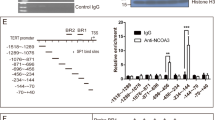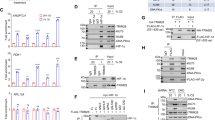Abstract
Hypoxia-inducible factor 1 (HIF-1) is a key regulator of O2 homeostasis, which regulates the expression of several genes linked to angiogenesis and energy metabolism. Tumor hypoxia has been shown to be associated with poor prognosis in a variety of tumors, and HIF-1 induced by hypoxia plays pivotal roles in tumor progression. The presence of putative HIF-1-binding sites on the promoter of human telomerase reverse transcriptase gene (hTERT) prompted us to examine the involvement of HIF-1 in the regulation of hTERT and telomerase in tumor hypoxia. The telomeric repeat amplification protocol (TRAP) assay revealed that hypoxia activated telomerase in cervical cancer ME180 cells, with peak induction at 24–48 h of hypoxia. Notably, hTERT mRNA expression was upregulated at 6–12 h of hypoxia, concordant with the elevation of HIF-1 protein levels at 6 h. hTERT protein levels were subsequently upregulated at 24 h and later. Luciferase assays using reporter plasmids containing hTERT core promoter revealed that hTERT transcription was significantly activated in hypoxia and by HIF-1 overexpression, and that the two putative binding sites within the core promoter are responsible for this activation. Chromatin immunoprecipitation assay identified the specific binding of HIF-1 to these sites (competing with c-Myc), which was enhanced in hypoxia. The present findings suggest that hypoxia activates telomerase via transcriptional activation of hTERT, and that HIF-1 plays a critical role as a transcription factor. They also suggest the existence of novel mechanisms of telomerase activation in cancers, and have implications for the molecular basis of hypoxia-induced tumor progression and HIF-1-based cancer gene therapy.
This is a preview of subscription content, access via your institution
Access options
Subscribe to this journal
Receive 50 print issues and online access
$259.00 per year
only $5.18 per issue
Buy this article
- Purchase on Springer Link
- Instant access to full article PDF
Prices may be subject to local taxes which are calculated during checkout






Similar content being viewed by others
References
Akakura N, Kobayashi M, Horiuchi I, Suzuki A, Wang J, Chen J, Niizeki H, Kawamura KI, Hosokawa M and Asaka M . 2001. Cancer Res., 61, 6548–6554.
Birner P, Schindl M, Obermair A, Plank C, Breitenecker G and Oberhuber G . 2000. Cancer Res., 60, 4693–4696.
Carmeliet P, Dor Y, Herbert JM, Fukumura D, Brusselmans K, Dewerchin M, Neeman M, Bono F, Abramovitch R, Maxwell P, Koch CJ, Ratcliffe P, Moons L, Jain RK, Collen D, Keshert E and Keshet E . 1998. Nature, 394, 485–490.
Chin L, Artandi SE, Shen Q, Tam A, Lee SL, Gottlieb GJ, Greider CW and DePinho RA . 1999. Cell, 97, 527–538.
Coquelle A, Toledo F, Stern S, Bieth A and Debatisse M . 1998. Mol. Cell, 2, 259–265.
Elbashir SM, Harborth J, Lendeckel W, Yalcin A, Weber K and Tuschl T . 2001. Nature (Lond.), 411, 494–498.
Greenberg RA, Chin L, Femino A, Lee KH, Gottlieb GJ, Singer RH, Greider CW and DePinho RA . 1999. Cell, 97, 515–525.
Hockel M, Knoop C, Schlenger K, Vorndran B, Baussmann E, Mitze M, Knapstein PG and Vaupel P . 1993. Radiother. Oncol., 26, 45–50.
Huang LE, Gu J, Schau M and Bunn HF . 1998. Proc. Natl. Acad. Sci. USA, 95, 7987–7992.
Jiang BH, Agani F, Passaniti A and Semenza GL . 1997. Cancer Res., 57, 5328–5335.
Jiang BH, Semenza GL, Bauer C and Marti HH . 1996. Am. J. Physiol., 271, C1172–C1180.
Krishnamachary B, Berg-Dixon S, Kelly B, Agani F, Feldser D, Ferreira G, Iyer N, LaRusch J, Pak B, Taghavi P and Semenza GL . 2003. Cancer Res., 63, 1138–1143.
Kyo S, Takakura M, Taira T, Kanaya T, Itoh H, Yutsudo M, Ariga H and Inoue M . 2000. Nucleic Acids Res., 28, 669–677.
Maxwell PH, Dachs GU, Gleadle JM, Nicholls LG, Harris AL, Stratford IJ, Hankinson O, Pugh CW and Ratcliffe PJ . 1997. Proc. Natl. Acad. Sci. USA, 94, 8104–8109.
Mazure NM, Chauvet C, Bois-Joyeux B, Bernard MA, Nacer-Cherif H and Danan JL . 2002. Cancer Res., 62, 1158–1165.
Minamino T, Mitsialis SA and Kourembanas S . 2001. Mol. Cell. Biol., 21, 3336–3342.
Nakamura TM, Morin GB, Chapman KB, Weinrich SL, Andrews WH, Lingner J, Harley CB and Cech TR . 1997. Science, 1277, 955–959.
Ravi R, Mookerjee B, Bhujwalla ZM, Sutter CH, Artemov D, Zeng Q, Dillehay LE, Madan A, Semenza GL and Bedi A . 2000. Genes Dev., 14, 34–44.
Russo CA, Weber TK, Volpe CM, Stoler DL, Petrelli NJ, Rodriguez-Bigas M, Burhans WC and Anderson GR . 1995. Cancer Res., 55, 1122–1128.
Schreiber E, Matthias P, Muller MM and Schaffner W . 1989. Nucleic Acids Res., 17, 6419.
Schindl M, Schoppmann SF, Samonigg H, Hausmaninger H, Kwasny W, Gnant M, Jakesz R, Kubista E, Birner P and Oberhuber G . 2002. Clin. Cancer Res., 8, 1831–1837.
Seimiya H, Tanji M, Oh-hara T, Tomida A, Naasani I and Tsuruo T . 1999. Biochem. Biophys. Res. Commun., 260, 365–370.
Semenza GL . 1999. Annu. Rev. Cell Dev. Biol., 15, 551–578.
Semenza GL . 2000. Genes Dev., 14, 1983–1991.
Sivridis E, Giatromanolaki A, Gatter KC, Harris AL and Koukourakis MI . 2002. Cancer, 95, 1055–1063.
Takakura M, Kyo S, Kanaya T, Hirano H, Takeda J, Yutsudo M and Inoue M . 1999. Cancer Res., 59, 551–557.
Wang GL, Jiang BH, Rue EA and Semenza GL . 1995. Proc. Natl. Acad. Sci. USA, 92, 5510–5514.
Wu KJ, Grandori C, Amacker M, Simon-Vermot N, Polack A, Lingner J and Dalla-Favera R . 1999. Nat. Genet., 21, 220–224.
Xu D, Popov N, Hou M, Wang Q, Bjorkholm M, Gruber A, Menkel AR and Henriksson M . 2001. Proc. Natl. Acad. Sci. USA, 98, 3826–3831.
Yasumoto S, Kunimura C, Kikuchi K, Tahara H, Ohji H, Yamamoto H, Ide T and Utakoji T . 1996. Oncogene, 13, 433–439.
Acknowledgements
This study was supported in part by a Grant-in Aid for the Second-Term Comprehensive 10-Year Strategy for Cancer Control from the Ministry of Health and Welfare, Japan, and Megumi Medical Foundation, Kanazawa University. We thank Dr Eric Haung, National Cancer Institute, National Institutes of Health, Bethesda, MD, for providing the HIF-1α expression vector.
Author information
Authors and Affiliations
Corresponding author
Rights and permissions
About this article
Cite this article
Yatabe, N., Kyo, S., Maida, Y. et al. HIF-1-mediated activation of telomerase in cervical cancer cells. Oncogene 23, 3708–3715 (2004). https://doi.org/10.1038/sj.onc.1207460
Received:
Revised:
Accepted:
Published:
Issue Date:
DOI: https://doi.org/10.1038/sj.onc.1207460
Keywords
This article is cited by
-
C11orf54 promotes DNA repair via blocking CMA-mediated degradation of HIF1A
Communications Biology (2023)
-
Angiogenic signaling pathways and anti-angiogenic therapy for cancer
Signal Transduction and Targeted Therapy (2023)
-
The RabGEF ALS2 is a hypoxia inducible target associated with the acquisition of aggressive traits in tumor cells
Scientific Reports (2020)
-
Diverse regulatory manners of human telomerase reverse transcriptase
Cell Communication and Signaling (2019)
-
PKM2 enhances chemosensitivity to cisplatin through interaction with the mTOR pathway in cervical cancer
Scientific Reports (2016)



